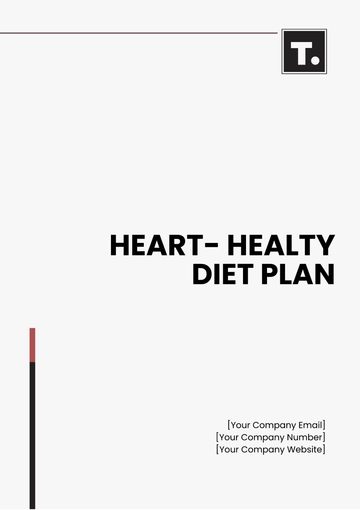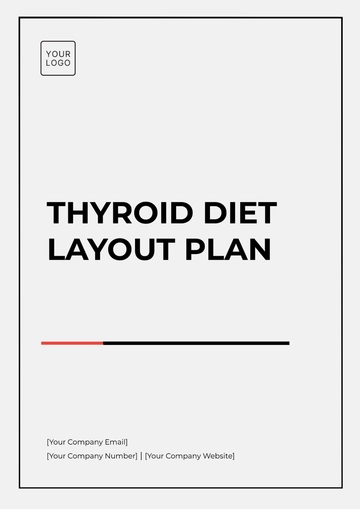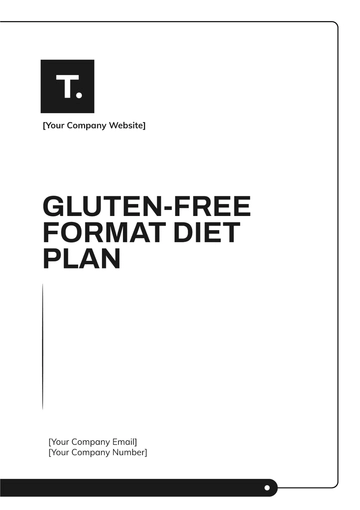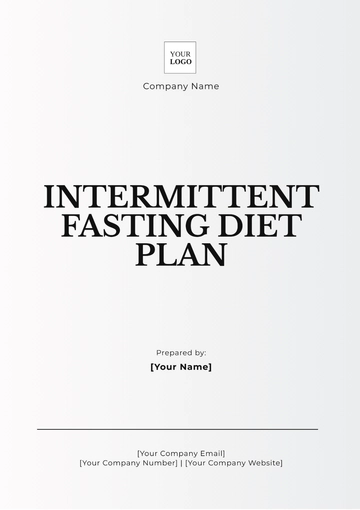Free Weekly Diet Plan

Written by: [YOUR NAME]
Contact Email: [YOUR EMAIL]
Prepared by: | [YOUR NAME] |
Hospital Name: | [YOUR HOSPITAL NAME] |
Hospital Address: | [YOUR HOSPITAL ADDRESS] |
Hospital Email: | [YOUR HOSPITAL EMAIL] |
Hospital Number: | [YOUR HOSPITAL NUMBER] |
Website: | [YOUR HOSPITAL WEBSITE] |
Social Media: | [YOUR HOSPITAL SOCIAL MEDIA] |
I. Introduction
A. Purpose
Welcome to your personalized Weekly Diet Plan. This plan outlines daily meals and snacks to help you achieve your nutritional goals. Each meal is designed to be balanced, wholesome, and satisfying.
B. How to Use This Plan
Follow the meal schedule as closely as possible. Use the tips and recommendations section to tailor the plan to fit your lifestyle, especially when dining out or during social occasions.
C. Important Notes
Always consult with your physician or dietitian before starting any new diet plan.
Adjust portions based on your individual needs and hunger levels.
Stay hydrated by drinking at least 8 glasses of water a day.
II. Weekly Meal Schedule
Daily Breakdown
Week | Breakfast | Snack | Lunch | Snack | Dinner |
|---|---|---|---|---|---|
Monday | Oatmeal with berries | Apple, almonds | Quinoa salad with veggies | Greek yogurt | Grilled chicken with broccoli |
Tuesday | Scrambled eggs, toast | Mixed fruit | Turkey sandwich, salad | Protein shake | Baked salmon, asparagus |
Wednesday | Smoothie bowl | Carrot sticks, hummus | Lentil soup, bread | Cottage cheese | Stir-fried tofu, vegetables |
Thursday | Greek yogurt, granola | Banana, peanut butter | Chickpea salad wrap | Nuts, dried fruit | Beef stir-fry, brown rice |
Friday | Avocado toast | Celery, nut butter | Chicken Caesar salad | Cheese sticks | Shrimp, quinoa, spinach |
Saturday | Pancakes, fresh fruit | Orange slices | Tuna salad, crackers | Smoothie | Turkey meatballs, zucchini noodles |
Sunday | Scrambled tofu, veggies | Berry mix | Grilled cheese, tomato soup | Trail mix | Roasted pork, sweet potatoes |
III. Tips and Recommendations
A. Portion Control
Portion control is crucial for maintaining a healthy diet. Here's a breakdown of how to effectively control your portions:

Use Smaller Plates: Opting for smaller plates can trick your brain into feeling satisfied with smaller portions. This visual cue can help you consume fewer calories without feeling deprived.
Fill Half Your Plate with Vegetables: Vegetables are low in calories and high in nutrients. By filling half your plate with vegetables, you can increase your fiber intake, feel fuller, and naturally consume fewer calories from higher-calorie foods.
Avoid Second Servings: After finishing your meal, wait for about 20 minutes before considering a second serving. It takes time for your brain to register that you're full, so giving yourself a break can prevent overeating.
B. Meal Timing
Maintaining consistent meal times and frequency is essential for regulating your metabolism and preventing energy crashes. Here are some tips for effective meal timing:
Consistent Meal Times: Try to eat meals at roughly the same times each day. This helps regulate your body's internal clock and can prevent excessive hunger or snacking between meals.
Don't Skip Meals: Skipping meals can lead to overeating later in the day and disrupt your body's natural hunger cues. Aim to eat three balanced meals and two healthy snacks throughout the day to keep your energy levels stable.
Early Dinner: Having dinner at least two hours before bedtime allows your body enough time to digest food before you sleep. This can improve sleep quality and prevent indigestion or discomfort during the night.
C. Strategies for Dining Out
Eating out can present challenges when trying to maintain a healthy diet, but with some planning and mindfulness, you can make healthier choices:
Review the Menu: Before dining out, take a look at the menu online if possible. Look for healthier options like grilled or steamed dishes, and avoid items that are fried or heavily processed.
Ask for Modifications: Don't be afraid to ask for dressings or sauces on the side, or request substitutions like steamed vegetables instead of fries. Many restaurants are willing to accommodate special requests.
Share or Take Home: Restaurant portions are often larger than necessary. Consider sharing a dish with a friend or taking half of it home for later. This can prevent overeating and reduce food waste.
D. Social Occasions
Social events often revolve around food, but you can still enjoy yourself while making healthier choices:
Eat a Healthy Snack: Before attending an event, have a small, healthy snack like a piece of fruit or a handful of nuts. This can help curb your appetite and prevent overindulging on less healthy options later.
Focus on Socializing: Instead of solely focusing on the food, prioritize socializing with friends and family. Engage in conversation, participate in activities, and enjoy the company rather than constantly grazing on snacks.
Choose Smaller Portions: If there's a buffet or a variety of food available, opt for smaller portions of each item rather than loading up your plate. This allows you to sample a variety of foods without overdoing it.
IV. Conclusion
Summary
In summary, this Weekly Diet Plan serves as a comprehensive guide for achieving balanced nutrition and fostering a healthy lifestyle. By following the provided meal schedule and implementing the tips and recommendations, you can optimize your dietary habits and work towards your wellness goals.
Balanced Nutrition: This plan offers balanced meals and snacks for optimal nutrition.
Consistency is Key: Stick to the schedule and tips for lasting results.
Mindful Eating: Being mindful aids in healthier food choices and portion control.
Long-Term Success: Commitment to this plan yields sustained health benefits.
Commit to this Weekly Diet Plan and make gradual changes to your eating habits for improved energy, better health, and enhanced well-being. Cheers to your health and success!
Thank you for embracing our Weekly Diet Plan, fostering healthier eating habits, and supporting individuals in achieving nutritional goals for a better lifestyle.
- 100% Customizable, free editor
- Access 1 Million+ Templates, photo’s & graphics
- Download or share as a template
- Click and replace photos, graphics, text, backgrounds
- Resize, crop, AI write & more
- Access advanced editor
Discover the ultimate solution to your dietary journey with the Weekly Diet Plan Template from Template.net. Crafted to be both editable and customizable, this template empowers you to tailor your meal plans effortlessly. With seamless compatibility in our Ai Editor Tool, achieving your health goals has never been more convenient.





























